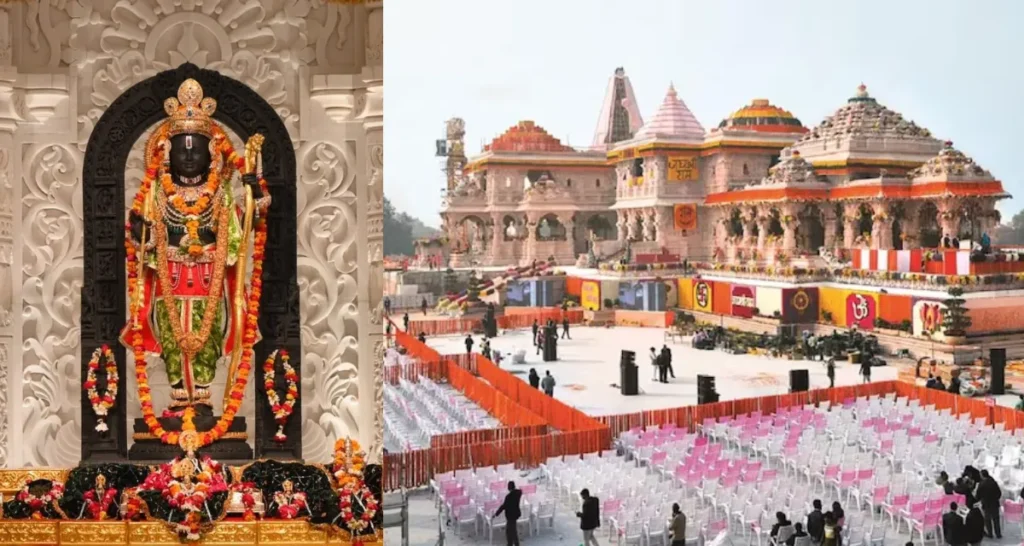In the heart of Ayodhya, a majestic temple dedicated to Lord Ram is taking shape. But this isn’t just any temple, it’s a blend of ancient faith and modern science.

Scheduled for consecration on 22 January 2024, the Ayodhya Ram Mandir is not only a place of worship but also a marvel of engineering designed to withstand the test of time.
Design and Construction Ayodhya Ram Mandir
The Ayodhya Ram Mandir’s design draws inspiration from traditional Nagara style architecture, featuring 360 pillars entirely crafted from stone. Unlike modern materials like iron or steel, stone was chosen for its longevity and durability, especially in the face of earthquakes.
Constructed by Larsen and Toubro with management by Tata Consulting Engineers Limited, every aspect of the Ayodhya Ram Mandir has been meticulously planned.
Ayodhya Ram Mandir Foundation Innovation
One of the most innovative aspects of the Ayodhya Ram Mandir construction is its foundation. Sitting on a 15 meter thick layer of rolled compacted concrete, this Ram Mandir foundation comprises 56 layers made from fly ash, dust and chemicals.
The choice of stone and this robust foundation make the structure earthquake resistant, ensuring it can withstand seismic activities.
Challenges and Solutions Regarding Ayodhya Ram Mandir Construction
The construction of Ayodhya Ram Mandir posed unique challenges, such as maintaining the temperature of self compacting concrete during pouring. To overcome this, on site ice crushing plants were employed and the foundation was filled only at night to minimize the impact of external temperatures.
Also Read: Day 3 of Ram Mandir Pran Pratishtha: Ram Lalla Placed in Garbha Griha
These measures were part of a series of innovations that involved a dedicated team of 150 engineers and thousands of workers.
Science Behind Ayodhya Ram Mandir
The Ayodhya Ram Mandir design isn’t just visually striking, it’s backed by scientific rigor. The Ram Mandir structure is engineered to endure an earthquake of up to magnitude 6.5 and is projected not to require repairs for an impressive 1000 years.
To achieve this, the team at IIT Chennai measured historical earthquake intensity in the region and simulated it in the laboratory, leading to a unique foundation design.
Re Engineered Soil of Ayodhya Ram Mandir
The Ayodhya Ram Mandir foundation’s re engineered soil can solidify into stone within 14 days, with 47 layers carefully laid during the construction process.
Also Read: Shri Ram Homecoming: Celebrating Lord Ram Return
Praised by the Director of CISR Central Building Research Institute in Roorkee, the use of stone in construction of Ayodhya Ram Mandir ensures longevity without the issue of rusting iron.
Ram Mandir Protection from Flooding
Engineers also considered flooding records of the region, confirming that the Ayodhya Ram Mandir construction level is safe from future flooding.
This meticulous planning reflects a deep understanding of the environment and a commitment to ensuring the Ayodhya Ram Mandir longevity.
Noon Reflection Mechanism
Adding a touch of spirituality, the Ram Mandir features a unique noon reflection mechanism designed by CBRI.
Also Read: Gulabi Meenakari Ram Mandir Replica by Kunj Bihari
This mechanism directs sunlight onto the Ram Lalla idol’s foreheads at noon during Ram Navami, enhancing the spiritual experience for devotees.
Conclusion
The Ayodhya Ram Mandir stands not only as a symbol of religious devotion but also as a testament to the harmonious integration of spirituality and scientific innovation.
From the choice of materials to the innovative foundation and environmental considerations, every aspect of the Ayodhya Ram Mandir construction reflects a commitment to building a structure that will endure for generations to come.
Also Read: January 23: Ayodhya Ram Mandir Opening Date for Devotees
As we witness the Ayodhya Ram Mandir consecration ceremony on 22 January 2024, let us marvel at the seamless fusion of ancient faith and modern science in this architectural wonder.






